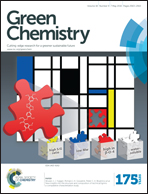A free-standing LiFePO4–carbon paper hybrid cathode for flexible lithium-ion batteries†
Abstract
Lithium-ion batteries (LIBs) are widely implemented to power portable electronic devices and are increasingly in demand for large-scale applications. One of the major obstacles for this technology is still the low cost-efficiency of its electrochemical active materials and production processes. In this work, we present a novel impregnation–carbothermal reduction method to generate a LiFePO4–carbon paper hybrid electrode, which doesn't require a metallic current collector, polymeric binder or conducting additives to function as a cathode material in a LIB system. A shell of LiFePO4 crystals was grown in situ on carbon fibres during the carbonization of microcrystalline cellulose. The LiFePO4–carbon paper electrode achieved an initial reversible areal capacity of 197 μA h cm−2 increasing to 222 μA h cm−2 after 500 cycles at a current density of 0.1 mA cm−2. The hybrid electrode also demonstrated a superior cycling performance for up to 1000 cycles. The free-standing electrode could be potentially applied for flexible lithium-ion batteries.


 Please wait while we load your content...
Please wait while we load your content...